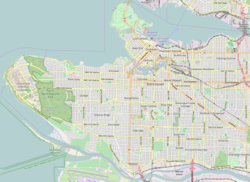Downtown Eastside | |
|---|---|
Neighbourhood | |
 The Downtown Eastside and Woodward's site at dusk, from Harbour Centre in summer 2018 | |
| Nicknames: DTES, Skid Row | |
| Coordinates: 49°16′53″N 123°05′59″W / 49.28139°N 123.09972°W | |
| Country | Canada |
| Province | British Columbia |
| City | Vancouver |
| Government | |
| • MP | Jenny Kwan |
| • MLA | Joan Phillip |
| Population (2011) | |
• Total | 18,477 for the greater DTES area |
• Estimate (2009) | 6,000 – 8,000 for the DTES |
| Time zone | UTC-8 (PST) |
| • Summer (DST) | UTC-7 (PDT) |
| Postal code | V6A |
| Area codes | 604, 778, 236, 672 |
The Downtown Eastside (DTES) is a neighbourhood in Vancouver, British Columbia, Canada. One of the city's oldest neighbourhoods, the DTES is the site of a complex set of social issues, including disproportionately high levels of drug use, homelessness, poverty, crime, mental illness and sex work. It is also known for its strong community resilience, history of social activism, and artistic contributions.
Around the beginning of the 20th century, the DTES was Vancouver's political, cultural and retail centre. Over several decades, the city centre gradually shifted westwards, and the DTES became a poor neighbourhood,[1] although relatively stable. In the 1980s, the area began a rapid decline due to several factors, including an influx of hard drugs, policies that pushed sex work and drug-related activity out of nearby areas, and the cessation of federal funding for social housing. By 1997, an epidemic of HIV infection and drug overdoses in the DTES led to the declaration of a public health emergency. As of 2018, critical issues include opioid overdoses, especially those involving the drug fentanyl; decrepit and squalid housing; a shortage of low-cost rental housing; and mental illness, which often co-occurs with addiction.
The population of the DTES is estimated to be around 7,000 people. Compared to the city, the DTES has a higher proportion of males and adults who live alone. It also has significantly more Indigenous Canadians, disproportionately affected by the neighbourhood's social problems.[2][3][4] The neighbourhood has a history of attracting individuals with mental health and addiction issues, many of whom are drawn to its drug market and low-barrier services. Residents experience Canada's highest rate of death from encounters with police,[5] and there is mutual mistrust between police and many homeless residents.
Since Vancouver's real-estate boom began in the early 21st century, the area has been increasingly experiencing gentrification. Some see gentrification as a force for revitalization, while others believe it has led to higher displacement and homelessness. Numerous efforts have been made to improve the DTES at an estimated cost of over $1.4 billion as of 2009. Services in the greater DTES area are estimated to cost $360 million per year.[6] Commentators from across the political spectrum have said that little progress has been made in resolving the issues of the neighbourhood as a whole, although there are individual success stories. Proposals for addressing the issues of the area include increasing investment in social housing, increasing capacity for treating people with addictions and mental illness, making services more evenly distributed across the city and region instead of concentrated in the DTES, and improving coordination of services. However, little agreement exists between the municipal, provincial and federal governments regarding long-term plans for the area.
- ^ Campbell, Boyd & Cutbert 2009, chapter 1.
- ^ Nagy, Melanie (27 May 2021). "SisterSpace: Canada's first and only overdose prevention site for women is saving lives". CTV News. Archived from the original on 28 May 2021. Retrieved 6 November 2021.
- ^ Mauboules, Celine (7 October 2020). Homelessness & Supportive Housing Strategy (PDF) (Report). City of Vancouver. p. 28.
- ^ "Aboriginal Health & Safety". WISH Drop-In Centre Society. Retrieved 6 November 2021.
- ^ Brend, Yvette (5 April 2018). "B.C. has country's highest rate of police-involved deaths, groundbreaking CBC data reveals | CBC News". CBC News.
- ^ Cite error: The named reference
Culbert2014was invoked but never defined (see the help page).
